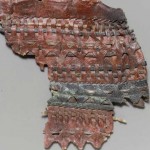Scientists at museum like the Met are using silver nanoparticles to analyze microscopic fragments of ancient art. This is a major advance because more conventional analysis requires a fairly sizable sample, which in some cases can be destructive to the artifact.
The nanoparticles also do a fantastic job highlighting ancient dyes, so you get to see the palette of antiquity in a whole new light.
Silver nanoparticles work by absorbing tiny amounts of dye molecules and enhancing the reading of diluted dyes. The nanoparticles also prevent otherwise fluorescent substances from reflecting too much light when a laser is shined on them.
Using such a tiny sample is important when art historians and scientists study small fragments of 4,000-year-old Egyptian letters. Removing even a tiny sample often destroys important details about the available technology and materials available to ancient civilizations.
 Using silver nanoparticles, Met scientist Marco Leona has identified a particular red dye called madder lake, derived from the madder plant.
Using silver nanoparticles, Met scientist Marco Leona has identified a particular red dye called madder lake, derived from the madder plant.
Making the dye from the plant is a complex chemical process, so the fact that the ancient Egyptians were making it as early as 1900 BC means they were even better chemists than we give them credit for.
Leona was also able to identify the same dye made from the shells of an Asian insect on two different 12th c. French statues. That suggests that Asian-European trade networks were more complex than previously imagined, even in the Middle Ages.
Damn, you really know how to turn me on. :boogie:
That was so totally what I was going for. 😎
This makes me think of the complex Phoenician process of extracting purple dye from Murex shells.
Also, nanoprobes will soon rule the world…
:skull: .
I saw that Naked Archaeologist guy trying to recreate the Murex dye process in Israel. That stuff must have reeked to high heaven. Real purty color, though.
I am always astounded by the variety of colors the ancients used…and the methods they discovered for creating dyes. I imagine there was much trial and error.
There had to have been. It’s weird to think about how colorful these marble and limestone cities were back then.